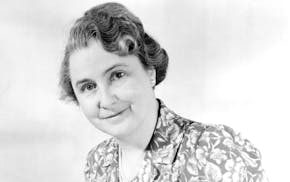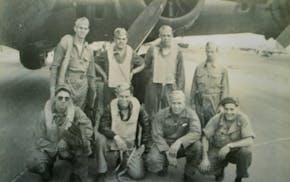The old, faded quilt remained rolled up in a plastic bag for eight years after Pamela Peterman inherited it from her great-aunt Frances. As she unfurled it on her kitchen table in Rosemount one recent Sunday morning, Peterman pointed out some of the 318 signatures embroidered in the quilt's blue-and-white checkered squares.
"It's kind of lumpy and not an example of fine quilt making, but the names on the quilt have started to speak to me," said Peterman, 78, who has spent more than 100 hours in the rabbit hole of online genealogy research.
She's investigated the names stitched in the signature quilt, including her great-aunt Frances Hagander Brazil and Frances' one-time housemate, Esther Swanson. They were 19-year-olds, Frances a server and Esther a cook, when they lived and worked at the Gardner House Hotel in Hastings.
Then there's the signature of V. Eugene Johnson — a missionary whose family survived a German boat attack in Tanganyika, now the east African nation of Tanzania.
"Look at this one," Peterman said to me, pointing out "Mrs. L.W. Youngdahl" stitched in blue thread. "It drives me crazy when women used their husbands' names."
The woman's full name was Irene Annet Engdahl Youngdahl, a daughter of Swedish immigrants who had majored in economics and English at Gustavus Adolphus College in St. Peter and graduated in 1919. Four years later, she married Luther Wallace Youngdahl, a fellow Gustie who later became a state Supreme Court justice, a federal judge and Minnesota's 27th governor from 1947 to 1951.
Peterman's sleuthing has answered some — but not all — of the questions surrounding the old quilt.
"The common connection was Messiah Lutheran Church," Peterman said, recalling her family's Swedish immigrant church in south Minneapolis that opened in 1917 and was razed in 2018. The congregation lives on at a nearby community center, and the Minneapolis campus of Children's Minnesota Hospital occupies the site where the old altar stood beneath a splendid stained-glass window of Christ with the words "Father, Thy Will be Done."
Scouring a 1946 church directory, Peterman identified many of the names on the quilt — which she's dated to the 1920s based on birth and death records of the stitched names.
"I wish I knew why it was made," Peterman said. "But my best guess is it was a fundraiser of some kind and people paid maybe a dime to add their name to raise money for the church."
Peterman received the quilt from her second cousin Barb Brazil Anderson of Minneapolis, who inherited the blanket from her grandmother: Frances Brazil. Frances might have won the quilt in a church raffle, "or she might have spearheaded the whole deal," Peterman said. "No one knows."
"It's not a striking quilt, and it's pretty faded," said Carolyn Silflow of Roseville, who has documented hundreds of quilts for the Minnesota Quilt Project — a group that has spent decades researching and photographing quilts in the state.
"Quilts really tell women's history because it was a way for women to express their artistic sides, all the while making something useful," said Silflow, a retired University of Minnesota biology professor.
Silflow stopped by Peterman's house earlier this month to check out the signature quilt. She was more impressed with Peterman's research than the stitchery.
"She really impressed me with her dogged dedication to researching this quilt," Silflow said. "The quilt immediately struck me as significant with all these names and history of a church community."
Silflow said signature quilts "are not super rare but not something we see everyday, either." They often raised money for charities, and the signatures are usually the quilts' lone design element.
In her writeup for the Minnesota Quilters newsletter, Silflow described Peterman's quilt in the parlance of quilters: "Made from Jacks on Six blocks (also known as Double X, Old Maid's Puzzle, Cat's Cradle)." She reported it's "machine-pieced and hand quilted" and that the names "appear to be stitched with the same hand."
Silflow began documenting Minnesota quilts in the early 1990s. Her all-time favorite? A Depression-era "Grandmothers' Flower Garden Quilt" by Agnes Kueppers of St. Paul that employs 189 different floral print fabrics in rings of hexagons. Kueppers, who died at 94 in 1992, won a 1942 blue ribbon at the State Fair for that one.
Peterman's quilt likely won't end up in such rarified air. But Silflow will forward information about it to the Quilt Index, a database at Michigan State University that includes nearly 6,000 Minnesota quilts at tinyurl.com/MNquilts. You can learn more about the Minnesota Quilt Project at tinyurl.com/MNQuiltProject.
"Researching the names on my quilt has turned into an obsession for me," Peterman said, "maybe because it's not something I have to do — but more what I want to do."
Curt Brown's tales about Minnesota's history appear each Sunday. Readers can send him ideas and suggestions at mnhistory@startribune.com. His latest book looks at 1918 Minnesota, when flu, war and fires converged: strib.mn/MN1918.

Minnesota History: Ad man turned Paul Bunyan into a folklore icon

Minnesota History: James Griffin used persistence to blaze a trail for St. Paul's Black police officers

Minnesota History: For Granite Falls doctor who tested thousands of kids for TB, new recognition is long overdue

Minnesota History: A New Ulm baker wearing a blanket fell to friendly fire in the U.S.-Dakota War


